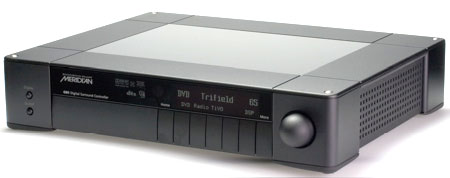Meridian G61 THX Surround EX Ultra2-Certified Surround Pre/Pro & G55 Five-Channel Amplifier

Both the G61 and G55 are in Meridian's lower priced (for them) G-Series line. Nevertheless, these are high performance, audiophile quality products. Their handsome exteriors, available in either black or brushed aluminum, are built to fortress-like standards, standards not seen in the more familiar world of flimsy, sheet metal chassis and cardboardy covers that flex when you look at them funny. I didn't take either unit apart, but I have seen the innards of other Meridian products, so I believe it's safe to say that the interior build quality here matches that of the outer façades.
The THX Ultra2-certified G61 ($5,495) is unique in that, unlike virtually every preamp/processor you're likely to encounter, it doesn't incorporate video switching. Some manufacturers offer means by which noisy, audio polluting, video circuitry can be shut off when not in use. For this high performance audio product, Meridian chose to omit video altogether in order to maximize audio performance even when you're watching video.
The G55 ($5,385) is an unusually flexible five-channel power amplifier rated at 100-watts into 8 ohms, 160-watts into 4 ohms, and 300-watts in paired bridged mode. It's fully balanced and offers passive bi-wiring facilities on all five channels, with bi-amping also possible. Utilizing a pair of G55s would allow you to bridge pairs of amplifiers to produce 300-watts for each the L/C/R channels across the front, while leaving four 100-watt amplifiers for surround and/or rear surrounds. Meridian supplied a single G55, limiting the review system to 5.1 channels.
More On the G61
The G61's lack of video switching leaves you with a choice: add a separate video switcher, or find a way to configure your A/V system to utilize your display device's switching facilities. If you're running a projector and have multiple video sources, you'll most likely need that switcher if only to avoid having to run multiple sets of HDMI or component video cabling to the ceiling.

In my system, I simply connected my HD cable box directly to the long length of component video cabling already running across my attic to my HDTV and moved my DVD player to the other side of the room, setting it atop my TV. Fortunately I had run a long length of Toslink across the attic as well, so getting Dolby Digital and DTS signal back to the processor for DVD was simple.
(From a marketing perspective, the omission of video switching in the G61 might not have seemed as risky when this pre/pro was conceived as it does today. HDMI switching, in particular, is becoming ubiquitous, carrying not only video but also hi-res audio from both Blu-ray and HD DVD. – Ed)
The lack of video switching aside, the G61 is a full featured preamp/processor that includes 12 assignable coaxial digital inputs, six of which can be used as two multichannel digital inputs with devices such as Meridian's G98DH DVD player, which includes Meridian's proprietary MHR (Meridian High Resolution). MHR is a secure encrypted link that allows a Meridian disc player to send six individual channels of information (over three digital coax connections) from DVD-A discs to the pre/pro in the digital domain instead of first converting it to analog. Meridian didn't supply an MHR compatible player so I didn't test this feature during this review.
In addition, there are five assignable Toslink optical digital audio inputs. The G51 also includes five pairs of single-ended stereo inputs and a six-channel analog input (also single-ended).
Meridian manufactures unique speaker systems that accept signals in the digital domain and utilize integrated D/A conversion and power amplification. To that end, the G61 includes 10 digital outputs- L/R front, center, two subs, both L/R side and L/R rear channels, or if you don't use four surrounds those channels can be configured for additional subs. However, the G61's hardware is designed to process up to 12 completely independent output channels. Current software "limits" the processing to a mere eight channels, but should ceiling or other surround channels become viable, the Meridian (unlike your wife, or perhaps even you) is ready. There are also eight single-ended analog outputs for conventional amp/speaker systems.
According to the spec sheet the G61 performs all processing at high sampling rates with 24-bit resolution at up to 192kHz, powered by three Motorola 56367 DSP devices running at 150MHz. Analog signals are automatically converted at 24-bits/96kHz, while digital inputs are reclocked to minimize jitter.
(For the multichannel analog input in particular, this reconversion to digital has both negative and positive implications. Negative in that the additional A/D and D/A stages may degrade the signal somewhat—though Meridian's digital processing is widely recognized as among the best. Positive in that it allows the user to bypass the limited bass management and crossover filters found in most high-definition disc players in favor of the superior processing available from a good pre-pro like the G61.—Ed.)
The processor can decode Dolby Digital, DTS, MPEG surround and AAC, and it includes an alphabet soup of common DSP modes such as Pro-LogicIIx (movie, music and THX) as well as Ambisonics, Trifield, MusicLogic and many, many others, too tedious to mention.
Also included is Meridian's proprietary inter-component communications system, which was not used for the purposes of this review.
Connecting and Configuring the G61/G55 Combo (In a Conventional, Non-Meridian A/V System) While the G55 offers balanced inputs, the G61's outputs are single-ended. So that's how the amp was used, in unbridged mode.

























































